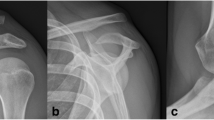Abstract
Purpose
To define the prevalence of associated articular injuries in patients with severe (Rockwood’s III–VI) acute acromioclavicular joint injuries and to find out how many of these were associated with the traumatic event and required surgical treatment.
Methods
Retrospective observational multicentric study performed in ten centres included patients who required surgery for acute acromioclavicular joint injuries between 2010 and 2017. The inclusion criteria were: presence of an acute acromioclavicular joint injury (grades III–IV–V–VI) and surgical treatment within 3 weeks of injury that included a full arthroscopic evaluation of the shoulder. Basic epidemiological data, severity of the original injury, prelesional sport level and prelesional work site requirements were recorded. The presence of intraarticular glenohumeral lesions and information of their characteristics, treatment, and whether each lesion was considered acute or pre-existing was also recorded.
Results
Two-hundred one subjects [mean (SD) age 36.7 (11.7) years] with acute acromioclavicular joint injuries (110 Rockwood type III, 34 type IV, 56 type V and 1 type VI) fulfilled the inclusion criteria. A total of 28 (13.9%) associated articular lesions were found. These lesions were more often found in grade IV injuries (26.5% in grade IV vs 11.4% in grade III, p = 0.037) and presented in males (18.7% in males vs 4% in females, p = 0.015). Age, laterality, sport level or work requirements did not affect the prevalence of associated lesions. Twelve were rotator cuff tears (6 PASTA lesions, 3 partial supscapularis tears, 2 bursal supraspinatus tears and 1 full-thickness supraspinatus tear), 16 were labral tears (9 anterior, 1 posteroinferior and 6 SLAP). Only 14 (50% of lesions, 7% of total subjects) were considered acute and all but one (an SLAP type 2 tear) required further surgical attention. Most pre-existing lesions were left untreated (n = 7) or managed with minimal debridement (n = 6), and only two required further surgery. The prevalence of associated lesions that required surgical management was 7.46%.
Conclusions
The prevalence of relevant associated lesions in subjects with acute grade III to VI ACJI is relatively low. Only 14% of subjects have an associated lesion and only half of these required further surgical attention.
Level of evidence
Retrospective case series, level IV.
Similar content being viewed by others
References
Arrigoni P, Brady PC, Zottarelli L, Barth J, Narbona P, Huberty D et al (2014) Associated lesions requiring additional surgical treatment in grade 3 acromioclavicular joint dislocations. Arthroscopy 30:6–10
Balke M, Schneider MM, Shafizadeh S, Bathis H, Bouillon B, Banerjee M (2015) Current state of treatment of acute acromioclavicular joint injuries in Germany: is there a difference between specialists and non-specialists? A survey of German trauma and orthopaedic departments. Knee Surg Sports Traumatol Arthrosc 23:1447–1452
Jensen G, Katthagen JC, Alvarado LE, Lill H, Voigt C (2014) Has the arthroscopically assisted reduction of acute AC joint separations with the double tight-rope technique advantages over the clavicular hook plate fixation? Knee Surg Sports Traumatol Arthrosc 22:422–430
Jensen G, Millett PJ, Tahal DS, Al Ibadi M, Lill H, Katthagen JC (2017) Concomitant glenohumeral pathologies associated with acute and chronic grade III and grade V acromioclavicular joint injuries. Int Orthop. https://doi.org/10.1007/s00264-017-3469-3
Korsten K, Gunning AC, Leenen LP (2014) Operative or conservative treatment in patients with Rockwood type III acromioclavicular dislocation: a systematic review and update of current literature. Int Orthop 38:831–838
Kramer MS (1988) Clinical epidemiology and biostatistics, Chapter 5, 1 ed. Springer, Berlin, pp 47–57
Lee YB, Kim J, Lee HW, Kim BS, Yoon WY, Yoo YS (2017) Arthroscopically assisted coracoclavicular fixation using a single flip button device technique: what are the main factors affecting the maintenance of reduction? Biomed Res Int 2017:4859262
Lemos MJ (1998) The evaluation and treatment of the injured acromioclavicular joint in athletes. Am J Sports Med 26:137–144
Liu X, Huangfu X, Zhao J (2015) Arthroscopic treatment of acute acromioclavicular joint dislocation by coracoclavicular ligament augmentation. Knee Surg Sports Traumatol Arthrosc 23:1460–1466
Pauly S, Gerhardt C, Haas NP, Scheibel M (2009) Prevalence of concomitant intraarticular lesions in patients treated operatively for high-grade acromioclavicular joint separations. Knee Surg Sports Traumatol Arthrosc 17:513–517
Pauly S, Kraus N, Greiner S, Scheibel M (2013) Prevalence and pattern of glenohumeral injuries among acute high-grade acromioclavicular joint instabilities. J Shoulder Elbow Surg 22:760–766
Ruiz Iban MA (2015) The acromioclavicular joint: lots of questions; too many answers? Rev Esp Artrosc Cir Articul 22:1–2
Schneider MM, Balke M, Koenen P, Frohlich M, Wafaisade A, Bouillon B et al (2016) Inter- and intraobserver reliability of the Rockwood classification in acute acromioclavicular joint dislocations. Knee Surg Sports Traumatol Arthrosc 24:2192–2196
Shin SJ, Jeon YS, Kim RG (2017) Arthroscopic-assisted coracoclavicular ligament reconstruction for acute acromioclavicular dislocation using 2 clavicular and 1 coracoid cortical fixation buttons with suture tapes. Arthroscopy 33:1458–1466
Stucken C, Cohen SB (2015) Management of acromioclavicular joint injuries. Orthop Clin N Am 46:57–66
Tischer T, Salzmann GM, El-Azab H, Vogt S, Imhoff AB (2009) Incidence of associated injuries with acute acromioclavicular joint dislocations types III through V. Am J Sports Med 37:136–139
Zhang LF, Yin B, Hou S, Han B, Huang DF (2017) Arthroscopic fixation of acute acromioclavicular joint disruption with TightRope: outcome and complications after minimum 2 (2–5) years follow-up. J Orthop Surg (Hong Kong) 25:2309499016684493
Funding
No funding was obtained to perform this research.
Author information
Authors and Affiliations
Corresponding author
Ethics declarations
Conflict of interest
The authors declare that they have no conflict of interest.
Ethical approval
IRB approval was obtained from the Clinical investigation and Ethics Committee of the Hospital Universitario Ramon y Cajal, Madrid, Spain.
Rights and permissions
About this article
Cite this article
Ruiz Ibán, M.A., Sarasquete, J., Gil de Rozas, M. et al. Low prevalence of relevant associated articular lesions in patients with acute III–VI acromioclavicular joint injuries. Knee Surg Sports Traumatol Arthrosc 27, 3741–3746 (2019). https://doi.org/10.1007/s00167-018-5089-x
Received:
Accepted:
Published:
Issue Date:
DOI: https://doi.org/10.1007/s00167-018-5089-x




